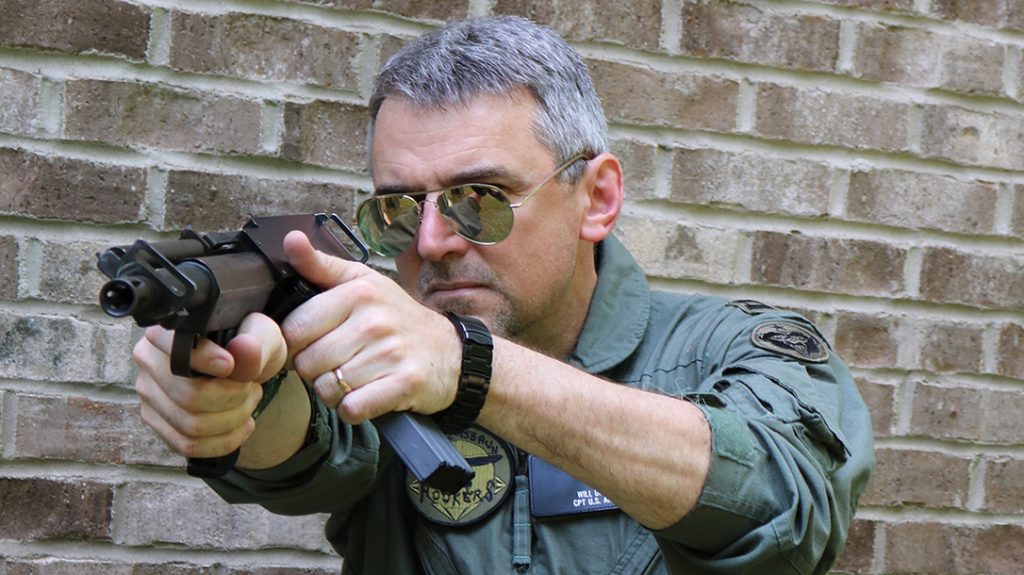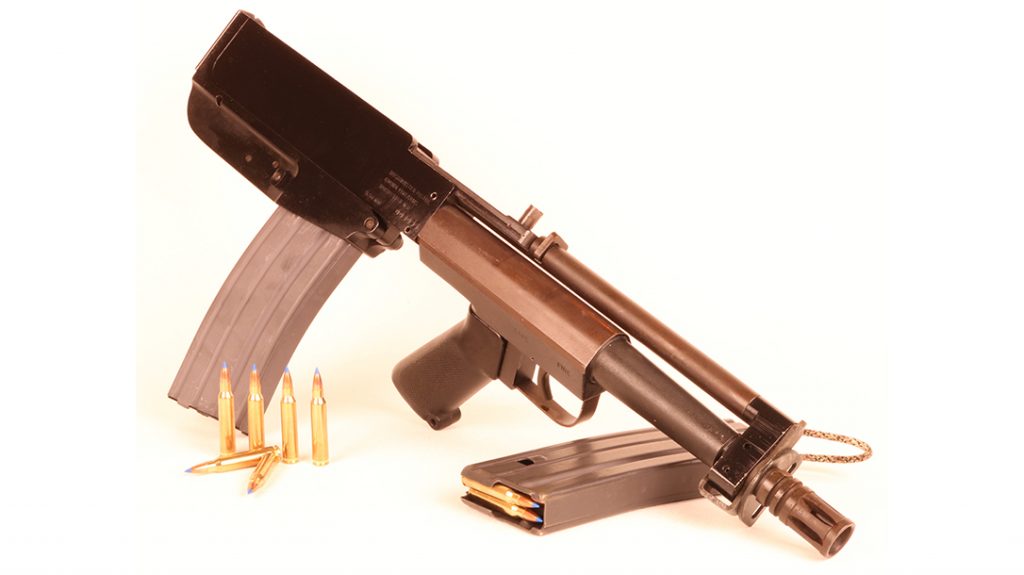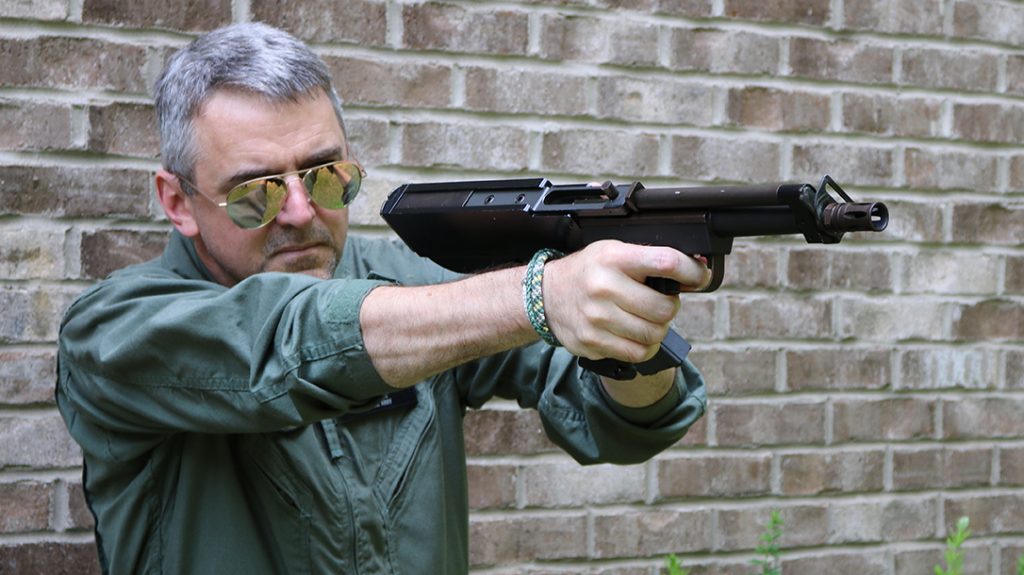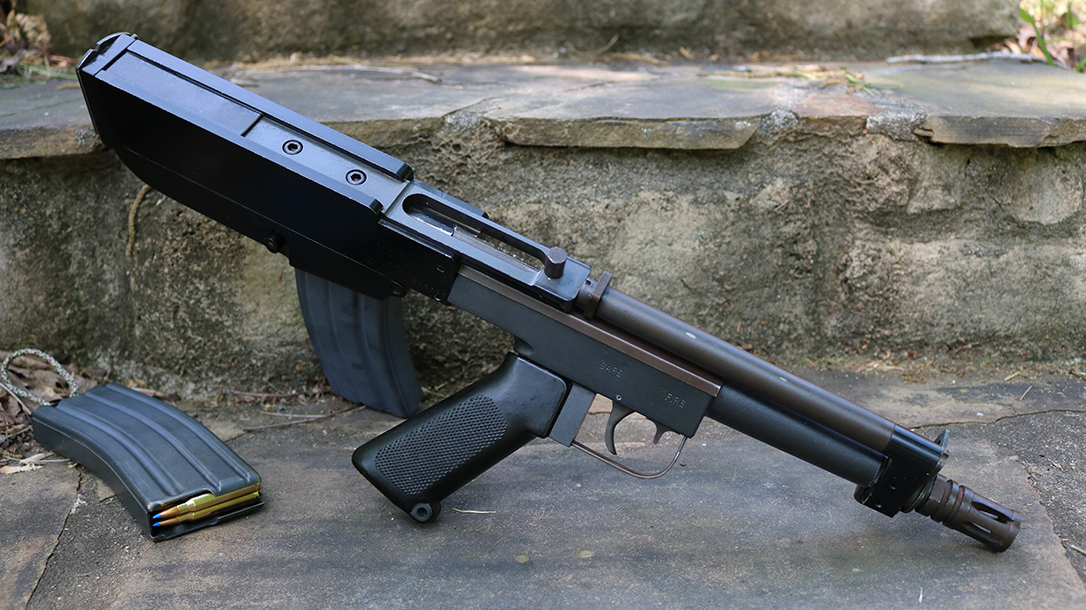Our tale begins at the USAF Armament Laboratory at Eglin Air Force Base in 1968. The war in Vietnam dominated the headlines, while the frenetic race to the moon drove unprecedented advances in technology. Amid this remarkable national milieu the USAF contracted with Colt to produce a radical new aircrew survival gun called the Individual Multi-Purpose Weapon or IMP-221. The USAF nomenclature was GUU-4/P.
How the Bushmaster Arm Pistol Came to Be
Chambered for the .221 Fireball/5.56x36mm wildcat cartridge, this novel bullpup design was intended to equip Air Force bomber crews operating over hostile territory. The original specifications demanded a gun less than 13 inches long. I would weigh less than 1.5 pounds while retaining an effective range of at least 100 meters. While the program itself did not result in a general-issue survival arm, the IMP-221 was the precursor to a broad array of personal defense weapons (PDW) that have subsequently seen wide distribution. The FN P90, HK MP7 and Indian Modern Submachine Carbine all indirectly owe their parentage to the IMP-221.
The IMP-221 was presciently revolutionary in a variety of ways. The gun’s 5.56x36mm round was 9mm shorter than a standard 5.56x45mm cartridge. It paved the way for the various dedicated PDW rounds in common use today. The IMP-221 action reflected a remarkably effective melding of the elegant rotating bolt of the M16 with the robust long-stroke gas-operated system of the AK. While dozens of manufacturers offer successful guns based upon this concept today, the IMP-221 seems to have been the first. The select-fire IMP-221 employed a novel mechanical rate reducer to keep its cyclic rate down to manageable levels. Additionally, the only hope the IMP designers had of meeting the demanding size and weight restrictions of the USAF program was to utilize a bullpup action.
Advertisement — Continue Reading Below
Origins
The term “bullpup” now refers to any firearm with an action oriented behind the fire controls. The Steyr AUG, the KelTec RFB, the FN F2000 and the Israeli Tavor are all successful examples of guns embodying this concept. The earliest known example came with the ill-fated British Thorneycroft bolt-action rifle designed in the early 20th century. The term “bullpup” began in the 1950s to describe any target pistol with particularly fancy grips. The true origins of the term, however, seem to have stemmed from a rare Japanese submachine gun developed during World War II.
The Japanese Experimental Model 2 was an odd though advanced design. Japanese Naval Infantry employed very small numbers during World War II in the Pacific. Firing the standard bottlenecked 8mm Nambu round via a magazine feeding through the pistol grip, the gun was not philosophically unlike an Uzi. The Model 2 nonetheless suffered terminal teething problems. American ordnance specialists encountered this unusual buzz gun. They declared it to be as rare as a “bullpup,” and the moniker stuck.
Morphology
Shooting from the hip is a lost art these days. Now we train to fire our weapons from the shoulder at all times, as this position provides the best accuracy and control without really sacrificing much speed. However, a commentary I once read penned by a young officer in the 101st Airborne Division during World War II opined that troopers of his day who could not engage targets accurately and fast with their primary weapons fired from the hip did not last long in combat. I lack the pedigree to dispute his assessment. The IMP-221 was itself a product of this somewhat archaic mindset.
Advertisement — Continue Reading Below

The IMP-221 design came fully ambidextrous. To accomplish this goal, the rear receiver portion of the weapon pivoted freely through about 30 degrees both right and left of the bore axis. The gun ejected from the top. This allowed the weapon to be used pressed alongside the shooter’s forearm in such a way as to be comparably effective when fired by either hand. The theory was that the gun would be pressed back against the operator’s bicep in lieu of a conventional shoulder stock and fired from the hip. The practical results, as is so often the case, were suboptimal.
Off-Shoots
The IMP-221, radical and revolutionary though it was, could not hope to meet the unreasonable stipulations of the Air Force program. The gun was indeed remarkably powerful for its size, and it offered unprecedented capabilities. However, the gun’s attributes were not so advanced over those of conventional handguns as to warrant a massive force-wide investment and adoption. Thus it might have been that the IMP-221 would have died a natural death were it not for a former Special Forces soldier named Mack Gwinn, Jr.
Advertisement — Continue Reading Below
Gwinn acquired the rights to the IMP-221 design and optimized it for civilian sales. The gun was chambered in 5.56x45mm and used standard M16 magazines. Gwinn marketed the tiny gun as the Bushmaster Arm Pistol. A subsequent rifle version was of a much more conventional layout, yet incorporated the Arm Pistol’s remarkably prescient hybrid action. While neither gun really caught on with American civilian shooters, Gwinn’s company went on to change hands and expand into a wide variety of black rifle variants before ultimately being sold to Bushmaster Firearms. The Bushmaster Arm Pistol remained in production from 1977 until 1988.
Design Particulars
The BAP’s barrel is just over 11 inches long, and the gun uses several standard AR parts. The entrails of the lower receiver will seem familiar to anyone who has ever torn down an AR rifle. Meanwhile, the rotating bolt looks almost identical to its AR counterpart.

Advertisement — Continue Reading Below
The sear takes the place of the more conventional trigger in an AR and incorporates a modest steel arm that reaches up to engage a transfer bar that runs back from the Arm Pistol’s trigger. This transfer device has a simple sheet steel hook on its end that tugs on the sear and fires the gun. In my gun, the safety is a sliding switch located within the triggerguard; it operates in a manner similar to that of an M1 Garand or MAC-10 submachine gun. Some versions instead sport a rotating safety lever akin to that of an AR rifle, located back in the receiver.
Hampered by Weaknesses
The gun’s charging device consists of a steel peg rigidly affixed to the bolt carrier. While the charging peg on my gun is oriented on the top of the carrier for easy access by either hand, some guns had this appendage on the left side. Most Arm Pistols included a standard M16 birdcage flash suppressor. Meanwhile some had a longer CAR-15 unit to help keep muzzle blast forward and away from the operator’s face.
The BAP’s sights proved to be the gun’s primary weakness. The design forced users to stabilize the shooter’s forearm to access the sights. This was an awkward and unstable maneuver under the best of circumstances. It was possible to fire the gun off the shoulder, but the sights were inaccessible in this configuration. Also, the violent ejection threatened facial trauma. The integral sights reside along the centerline at the front and back of the gun. But the charging handle mechanically occludes them at any angle. The rear sling mount on my particular copy has a corner ground away such that it can align with the corner of the front sling mount to serve as a rudimentary sighting device. Both of these components are readily reversible for right- or left-handed shooters.
Advertisement — Continue Reading Below
Practical Tactical
The BAP runs great from the hip. When it’s tucked into the right arm, backward pressure on the pistol grip locks the rear of the gun into the bicep for a fairly effective firing foundation. With a little practice we could keep our rounds on a standard silhouette out to 20 meters or so even in rapid fire. However, such an exercise is indeed innately imprecise.
Running the gun braced against the forearm proves relatively effective, but it remains an exercise in frustration. It is unduly tiring to manage the gun along an outstretched arm for long periods. Also, the sights are suboptimal on a good day. Some guns have had custom mounts attached for red-dot sights. Such an appendage should greatly enhance the gun’s effectiveness.

Advertisement — Continue Reading Below
The short barrel produces some truly breathtaking noise. Running this tiny gun so close to the face can be unsettling. The mag release is in essentially the same spot as on an AR. Magazine changes involve grasping the magazine with the left hand and pressing the release with the first or middle finger. The bolt locks to the rear on the last round fired. But it closes again automatically when the empty magazine is removed. This means a full magazine must be seated against the closed bolt—no mean feat when you’re rushed or terrified. Also, operators must manually cycle the bolt assembly with each reload.
Bushmaster Arm Pistol Hits and Misses
The safety on my gun is stiff but positive. As a result, I struggle to deactivate the device with my trigger finger. Guns with the safety built into the receiver require the safety switch to be manipulated with the weak hand. Twisting the rear portion of the gun left or right into firing position is a natural exercise. Additionally, the gun tends to hold its configuration once arranged. When it’s fully twisted, the ejection pattern is adequately displaced so as to assuage any concerns over facial injuries from being struck with hot brass while firing.
The ad hoc sights built into the sling mounts are grossly effective but obviously lack any method of adjustment. When it’s packed on a sling, the gun’s modest weight, compact dimensions and lack of protruding ditzels make it dreamy in the field.
Advertisement — Continue Reading Below
It is always an interesting exercise to ponder what might have been. While the Bushmaster Arm Pistol remains but a footnote in the annals of firearms design, it did pave the way for some heady stuff to come.
This article is from the March 2021 issue of Tactical Life magazine. Grab your copy at OutdoorGroupStore.com.
























